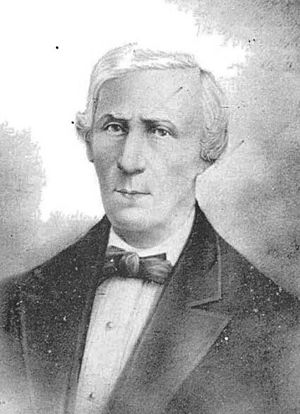José María Cornejo facts for kids
Quick facts for kids
José María Cornejo
|
|
|---|---|
 |
|
| 5th and 7th Political Chief of El Salvador | |
| In office 4 December 1830 – 3 April 1832 |
|
| President | José Francisco Barrundia Francisco Morazán |
| Preceded by | José Damián Villacorta |
| Succeeded by | Francisco Morazán |
| In office 30 January 1829 – 16 February 1830 |
|
| President | Manuel José Arce Mariano Beltranena y Llano José Francisco Barrundia |
| Preceded by | Mariano Prado |
| Succeeded by | José Damián Villacorta |
| Personal details | |
| Born |
José María Cornejo Merino
10 November 1788 San Vicente, New Spain |
| Died | 24 November 1864 (aged 76) San Vicente, El Salvador |
| Nationality | Salvadoran |
| Political party | Conservative |
| Spouse | Nicolasa de Lezama |
| Parents | José María Cornejo Jacoba Merino |
| Occupation | Politician |
José María Cornejo Merino (born November 10, 1788 – died November 24, 1864) was an important politician from El Salvador. He served as the leader, or "Chief of State," of El Salvador two different times. His first term was from 1829 to 1830, and his second was from 1830 to 1832.
Early Life of José María Cornejo
José María Cornejo was born in 1788. His parents were José María Cornejo and Jacoba Merino. He later married Nicolasa de Lezama.
He went to school in Guatemala. There, he studied philosophy and earned a diploma in 1809. He also started studying law, but he did not finish his degrees.
At this time, Central American countries were deciding their future. They were thinking about joining the First Mexican Empire led by Agustín de Iturbide. Cornejo did not agree with this idea. Because he opposed joining Mexico, he was put in prison. He was set free in June 1822 and went back to El Salvador.
José María Cornejo's Political Journey
Cornejo became a representative in the state congress. He served in this role in 1826, 1827, and 1828. During these years, El Salvador was part of the Federal Republic of Central America. He became quite well-known and also served as the mayor of his hometown, San Vicente.
When it was time to elect a new Chief of State for El Salvador, Cornejo won the election. He started his first term as leader on January 30, 1829. He governed for a little over a year, until February 16, 1830.
He began his second term as Chief of State on December 4, 1830. This term lasted until April 30, 1832. During this time, the President of the Central American Federation, Francisco Morazán, moved the capital from Guatemala City to San Salvador in December 1831.
Cornejo was against the idea of El Salvador being part of the Federation. Because of his strong opposition, Morazán had to leave San Salvador on January 6, 1832. Morazán went to Honduras to gather more soldiers. He planned to return to El Salvador later.
Cornejo, along with another politician named Manuel José Arce, announced that El Salvador was separating from the Central American Union in 1832. However, some towns in El Salvador did not agree with Cornejo. On March 17, 1832, the town of Chalatenango spoke out against Cornejo. The town of Metapán also supported the federal government.
Morazán's forces attacked San Miguel, El Salvador on February 28, 1832. Then, on March 14, 1832, Morazán defeated Cornejo's forces in the Battle of Jocoro. Morazán defeated him again in San Salvador on March 28. Cornejo was captured, and Morazán took direct control of El Salvador. Morazán then called for new elections. A special assembly was chosen, and they elected Mariano Prado as the new Chief of State. Joaquín de San Martín became the Vice Chief of State.
See also
 In Spanish: José María Cornejo para niños
In Spanish: José María Cornejo para niños

